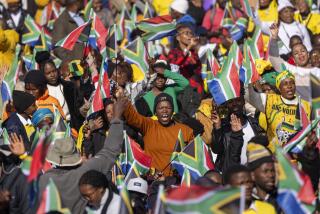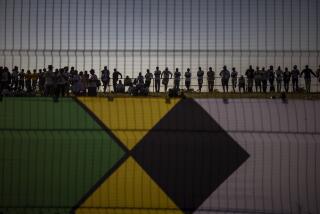Guerrillas Must Move Military Bases Out of Angola : S. Africa Rebels: A Changing War
- Share via
LUSAKA, Zambia — A white BMW, parked unobtrusively and packed with 200 pounds of dynamite, exploded last year outside a stadium in Johannesburg as thousands of white rugby fans were heading for their cars.
The attack was precisely planned, carefully executed and effective: The killing of two whites on a Saturday afternoon spread fear through South Africa’s white neighborhoods.
But it was also a mistake, violating the guerrillas’ standing orders against striking civilian targets.
“It was our operation,” said Chris Hani, chief of staff for the military wing of the African National Congress, making an unusual admission of ANC responsibility. “But it was not planned (by the military command) in Lusaka. And it was wrong.”
Home-Grown Units
The car bomb highlights the ANC’s increasing reliance on home-grown, home-trained and home-directed guerrilla units. Top rebel officials say they hope this strategic shift will overcome the hardship of moving five large guerrilla military bases out of Angola to comply with the U.S.-brokered Angolan peace agreement.
But attacks at sporting events, restaurants and shopping malls illustrate the difficulties the ANC faces these days in directing its guerrilla war from exile headquarters here in Zambia, 400 miles from the South African border, and in fending off accusations that its bombings are indiscriminate.
Hani and other members of the ANC’s military wing, Umkhonto we Sizwe, or Spear of the Nation, blame the civilian attacks on poor communications and frustration among local ANC operatives.
“They are bristling with impatience,” Hani said of his warriors. “They get passionate, angry. They say, ‘Let’s go punish those whites.’ It takes time to show them that we’re fighting a system, not a race.”
The South African police say the ANC committed a record 281 “acts of terror” in the past year, from hand-grenade explosions to assassinations. According to the police, 39 blacks and eight whites were killed in these incidents, and 500 people were injured.
In the month preceding October’s racially segregated municipal elections, South Africa suffered one bombing every 18 hours, on average. Most were directed at polling stations.
But the ANC, the primary guerrilla group fighting Pretoria’s white minority-led government, paid a heavy price. Government forces killed 48 suspected ANC soldiers and arrested 288 others in 1988, police say. And 122 alleged ANC members are standing trial in 38 courtrooms across South Africa on charges ranging from recruiting new members to terrorism and murder.
Another Blow in War
The rebels’ decision a few weeks ago to move five military training camps out of Angola would seem to be yet another blow to the guerrilla war begun 27 years ago under the command of Nelson R. Mandela. The ANC is said to be seeking permission to move those camps and several thousand soldiers to Tanzania and Ethiopia, even farther from South Africa.
ANC military and political strategists interviewed here say that although the move is inconvenient, it is unlikely to affect their fight against Pretoria.
“Our armed struggle is not de pendent on any base in a foreign country,” said Ronnie Kasrils, a senior ANC military strategist and one of two whites on the group’s 35-member national executive committee.
Kasrils and others believe that, in the long run, the agreement signed by Angola, South Africa and Cuba will benefit the rebels because it will bring independence to Namibia, the territory South Africa has ruled for 73 years. The ANC hopes that a one-person, one-vote government in Namibia will give hope to South Africa’s voteless black majority and rattle Pretoria’s leaders.
“There’s going to be the stench of betrayal in the nostrils of right-wing whites,” Kasrils predicted. “And to the more sane whites, there’s going to be the sense that the day of majority rule in South Africa is at hand.”
10,000 Guerrillas
The London-based International Institute for Strategic Studies estimates that the ANC has 10,000 guerrillas, many of them trained in Angola, the Soviet Union or Eastern Europe.
It has been without formal bases in countries bordering South Africa since 1984, when Mozambique signed a nonaggression pact with Pretoria and kicked out the rebel operations. All the so-called front-line states--the six black-ruled African nations (Angola, Botswana, Mozambique, Tanzania, Zambia and Zimbabwe) that lead the campaign against apartheid--are heavily dependent economically on South Africa and are subject to cross-border raids that Pretoria occasionally launches against what it says are rebel operations.
As a result, the ANC has begun building up its forces inside the country. It says that an internal army, supplied with arms and a few trained commanders from outside, will be in a better position to battle the government’s troops if the townships erupt in violent protest, as happened four years ago.
“We’ve had to push our people away from the idea that there is an invading army of the ANC coming to liberate them,” Hani said. “We’re trying to tell them it’s up to them. They must be ready.”
Aided by Crackdown
The government’s 2 1/2-year-old crackdown on anti-apartheid activity inside South Africa has helped the ANC’s recruiting effort, according to Hani.
“It used to be our people could release their anger through protest marches and speeches,” Hani said. “But the enemy has closed that chapter.”
The South African government considers the ANC, which it banned in 1960, a terrorist organization, and it has refused to negotiate with the group until it renounces violence. For its part, the ANC refuses to talk with the government until Pretoria abolishes the state of emergency, lifts the ban on anti-apartheid organizations and frees several thousand political prisoners.
The ANC’s armed struggle suffered some identity problems last year after the car bomb at Ellis Park and mine blasts at several Wimpy Bar fast-food restaurants.
Some analysts said a split had developed in the ANC upper echelon, between younger, more radical members such as Hani and the old guard represented by the group’s president, Oliver Tambo.
The radicals were said to believe that white South Africans would not be willing to push for change in the country until the guerrilla war came to their neighborhoods. Moderates within the organization argue that indiscriminate bombings hurt the ANC’s cause.
But rebel officials maintain that there is no serious rift and that attacks on purely civilian targets ended in September.
“We still believe that pressure against the (Pretoria) regime must be felt by those who give it maximum support, those who enjoy that life,” Hani said. “But we’re not saying every white person should be attacked. Our policy is to isolate the regime and show whites that there is an alternative.”
In fact, the ANC’s guiding principles, as set down in the 32-year-old Freedom Charter, demand that South Africa be ruled by all its citizens, white as well as black.
“The war must be spread to the white areas, but we must choose our targets carefully,” Hani said, suggesting symbols of the white power structure such as white soldiers and policemen. “We never had in mind attacking a Wimpy Bar or a restaurant. But people do things that basically run counter to our orders.”
The ANC rarely acknowledges responsibility for specific attacks, and it contends that some are carried out by a rival guerrilla group, the Pan-Africanist Congress, or by the government itself in an attempt to sully the ANC’s reputation.
The ANC is under intense pressure from inside the country to boost the morale of its supporters by “showing people that we can still give the government a blow,” Kasrils said.
Inevitably, the ANC says, some civilians will get caught in the middle.
“We do expect, now and again, some excesses,” Hani said. “Civilians will die in the crossfire. We regret it. But it will happen. There is no way to avoid it.”
More to Read
Sign up for Essential California
The most important California stories and recommendations in your inbox every morning.
You may occasionally receive promotional content from the Los Angeles Times.













